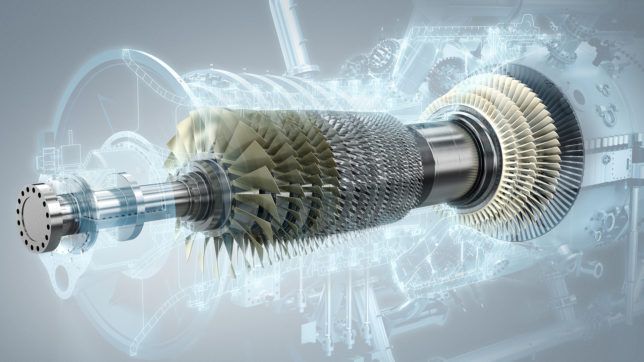VIRTUAL PROTOTYPING
USING 3D MULTIPHYSICS-BASED VIRTUAL PROTOTYPING TO IMPROVE GAS TURBINE EFFICIENCY AND RELIABILITY

BY CHAD CUSTER
Gas turbines (GTs) must be designed to produce energy as efficiently as possible, with components that must sustain reliable operation under extreme conditions. Complex aerodynamic and thermodynamic interactions are a major determinant of a turbine’s performance. As such, flow and thermal analysis methods are fundamentally important to the design process.
Some analysis methods rely on 1- and 2-dimensional correlation-based approximations. These approximations limit the accuracy of temperature predictions. 3-dimensional computational fluid dynamics (CFD) simulations can be used to predict complex flow fields and turbine blade metal temperatures accurately. This can be of assistance in improving gas turbine design.
Harsh environments
Turbine blades operate in harsh environments, with temperatures significantly higher than the melting point of the blade metal. Efficient operation relies on cooling provided by air routed through internal passageways. The goal of cooled turbine blade simulation is to accurately determine metal temperatures throughout the blade. These temperatures and the predicted aerodynamic loads allow for stress predictions to be performed. This helps establish the durability of the blade. The following analysis methods are used to predict the temperature of a candidate blade design:
LEGACY DESIGN SYSTEM: In this method, internal and external turbine blade flow fields are approximated using 1D correlations obtained from experimental data and simple relations. Results are used as inputs to a 3D finite element analysis (FEA) to predict blade temperatures. The process begins by specifying the cooling air being delivered to the blade and the aerodynamic conditions the blade will experience (boundary conditions). Additionally, a blade wall temperature is assumed. These data are used to determine the internal and external flow field. They provide the necessary boundary conditions for a 3D FEA analysis, which will result in a blade surface temperature distribution. This analysis cycle is repeated until the predicted blade surface temperature agrees with the assumed input. Each iteration is fast due to the simplicity of the models used, but accuracy can suffer. The correlation methods also rely on engine test data for correlation, meaning that experiments must be performed and only designs like those tested can be considered. Additionally, the analysis process relies on the maintenance of multiple tools, and the transmission of data between tools.
CFD-BASED DESIGN SYSTEM In this method, correlation-based flow field predictions are replaced by separate 3D CFD simulations of the internal and external blade flow paths. Results are used directly as inputs to 3D FEA analyses to obtain metal temperatures. The use of CFD allows 3D effects to be captured and accounted for in design iterations, reducing the reliance on prototype testing. The simulations of the internal and external flows can be performed simultaneously, but are not tightly coupled. The workflow has not changed from the legacy design system. The only change is that the correlation methods used for flow-field prediction have been changed to physics-based CFD models. Accuracy and design capability are improved, but the workflow remains cumbersome and error-prone.
CHT/CFD DESIGN SYSTEM It is possible to perform the entire analysis within one virtual prototype platform, if the platform can compute the heat transfer between the solid and fluid domains as part of the CFD simulation. This is commonly referred to as Conjugate Heat Transfer or CHT. This approach provides more accurate results and a simplified workflow. A single 3D multiphysics simulation can model the aerodynamics of the internal and external flow fields, as well as solid conduction. This shortens design time.
Validating the design system
Validation of the CHT/CFD methodology occurs in two stages. Simulations of individual turbine blade features are compared against experiments to determine best practices for subsequent simulations. Further simulation of blade geometry under engine operating conditions use these best practices. Predictions are compared to experimental data from engine tests to verify accuracy. Tests are done, for example, on single and multi-jet impingement, flow through ducts with ribbed surfaces to promote convective cooling (called turbulated ducts), and pin fins using measurements of the solid blade temperature of an H-class engine’s vane 1. The relative difference between the predicted and observed temperatures has a maximum deviation of 8%.
Thus, the integrated CHT/CFD workflow is capable of accurately predicting turbine blade metal temperatures. The 3D multi-physics-based approach represents a more accurate characterization of the system, enabling engineers to analyze and explore novel concepts beyond the scope of correlation-based methods.
Author: Dr. Chad Custer is Product Manager, Gas Turbines, at Siemens PLM Software. For more information, visit www.plm.automation. siemens.com/global/en/